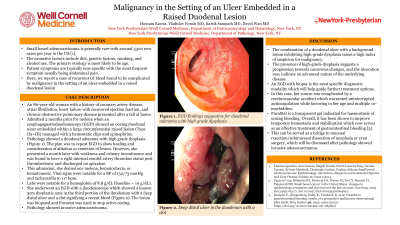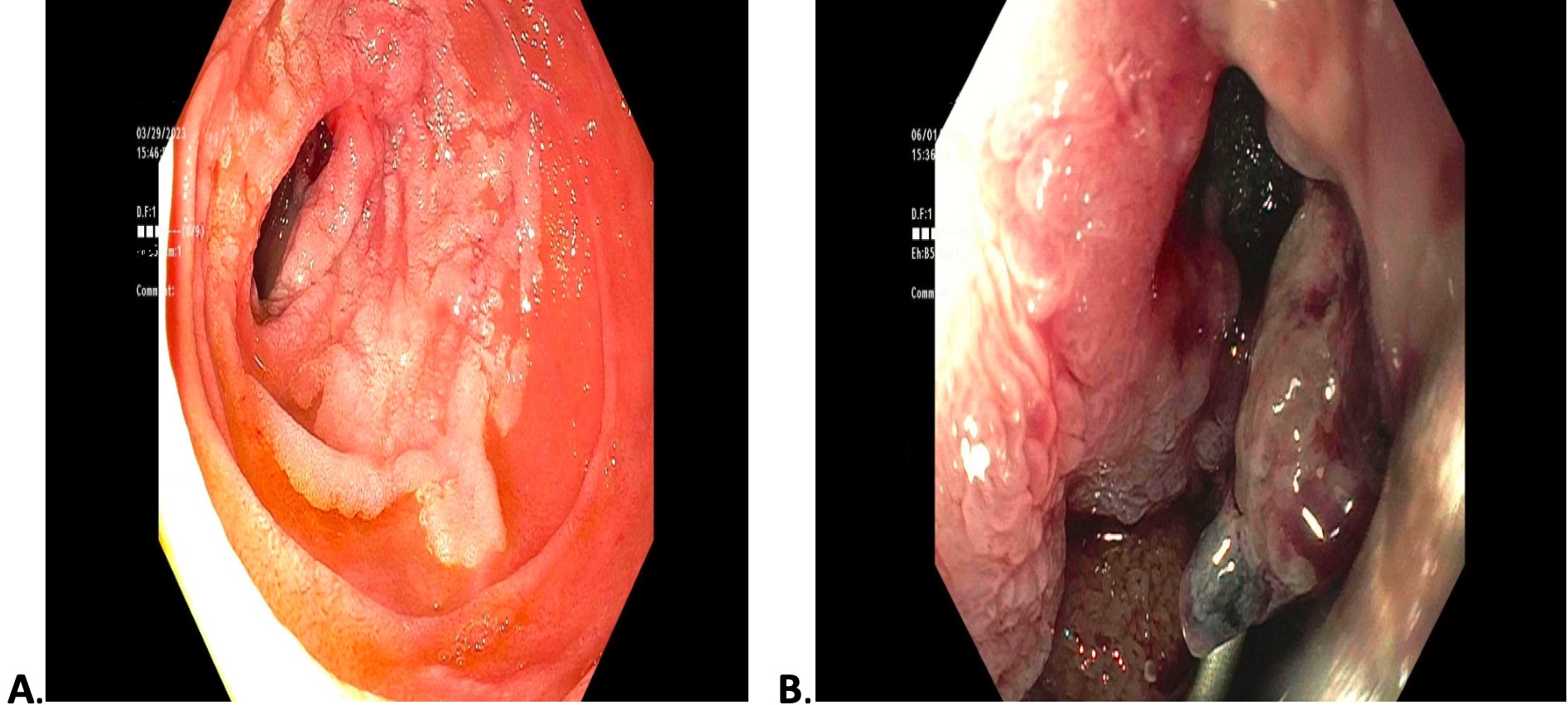Monday Poster Session
Category: Small Intestine
P2678 - A Case of Malignancy in the Setting of an Ulcer Embedded in a Raised Duodenal Lesion
Monday, October 23, 2023
10:30 AM - 4:15 PM PT
Location: Exhibit Hall

Has Audio

Hussam Kawas
Weill Cornell Medicine-Qatar
DOHA, Qatar
Presenting Author(s)
Hussam Kawas, 1, David Wan, BS, MD2, Vladislav Fomin, MD3, Kartik Sampath, MD4
1Weill Cornell Medicine-Qatar, New York, NY; 2Weill Cornell Medicine, New York, NY; 3New York-Presbyterian Hospital/Weill Cornell Medical College, New York, NY; 4New York-Presbyterian Hospital/Weill Cornell Medical Center, New York, NY
Introduction: This case of recurrent upper GI bleeding secondary to a duodenal ulcer embedded in a duodenal adenoma with high grade dysplasia raised suspicion for an underlying malignancy.
Case Description/Methods: An 86-year-old woman with a history of coronary artery disease, atrial fibrillation, heart failure with recovered ejection fraction, and chronic obstructive pulmonary disease who presents after a fall at home. She was admitted 2 months prior to this admission for melena when an esophagogastroduodenoscopy (EGD) showed one oozing duodenal ulcer embedded within a large circumferential raised lesion (Type IIa+III) managed with 3 hemostatic clips and epinephrine. Path showed duodenal adenoma with high grade dysplasia (Figure 1a). The plan was for repeat EGD to show healing and consideration of ablation or resection of lesion. However, presented a month later with weakness and urinary incontinence and was found to have a right internal carotid artery thrombus status post thrombectomy and discharged on apixaban. During the present admission, she denied any melena, hematochezia, or hematemesis. Vital signs were notable for a BP of 152/73 mmHg and tachycardia to 117 bpm. Labs were notable for a hemoglobin of 8.8 g/dL (baseline ~ 10 g/dL). The patient underwent an EGD which showed a known 3cm dysplastic area in the third portion of the duodenum with a deep distal ulcer and a clot signifying a recent bleed (Figure 1b). The lesion was biopsied and Purastat was used to stop active oozing. Pathology showed invasive adenocarcinoma.
Discussion: The combination of a duodenal ulcer with a background lesion exhibiting high-grade dysplasia raises a high index of suspicion for malignancy. The presence of high-grade dysplasia suggests a progression towards cancerous changes, and the ulceration may indicate an advanced nature of the underlying disease. An EGD with biopsy is the most specific diagnostic modality which will help guide further treatment options. In this case, her course was complicated by a cerebrovascular accident which warranted uninterrupted anticoagulation while factoring in her age and multiple co-morbidities. PuraStat is a transparent gel indicated for hemostasis of oozing bleeding. Overall, it has been shown to improve temporary hemostasis and stabilization which now serves as an effective treatment of gastrointestinal bleeding. This can be served as a bridge for endoscopic submucosal dissection of neoplasia or even surgery, which will be discussed after pathology showed invasive adenocarcinoma.

Disclosures:
Hussam Kawas, 1, David Wan, BS, MD2, Vladislav Fomin, MD3, Kartik Sampath, MD4. P2678 - A Case of Malignancy in the Setting of an Ulcer Embedded in a Raised Duodenal Lesion, ACG 2023 Annual Scientific Meeting Abstracts. Vancouver, BC, Canada: American College of Gastroenterology.
1Weill Cornell Medicine-Qatar, New York, NY; 2Weill Cornell Medicine, New York, NY; 3New York-Presbyterian Hospital/Weill Cornell Medical College, New York, NY; 4New York-Presbyterian Hospital/Weill Cornell Medical Center, New York, NY
Introduction: This case of recurrent upper GI bleeding secondary to a duodenal ulcer embedded in a duodenal adenoma with high grade dysplasia raised suspicion for an underlying malignancy.
Case Description/Methods: An 86-year-old woman with a history of coronary artery disease, atrial fibrillation, heart failure with recovered ejection fraction, and chronic obstructive pulmonary disease who presents after a fall at home. She was admitted 2 months prior to this admission for melena when an esophagogastroduodenoscopy (EGD) showed one oozing duodenal ulcer embedded within a large circumferential raised lesion (Type IIa+III) managed with 3 hemostatic clips and epinephrine. Path showed duodenal adenoma with high grade dysplasia (Figure 1a). The plan was for repeat EGD to show healing and consideration of ablation or resection of lesion. However, presented a month later with weakness and urinary incontinence and was found to have a right internal carotid artery thrombus status post thrombectomy and discharged on apixaban. During the present admission, she denied any melena, hematochezia, or hematemesis. Vital signs were notable for a BP of 152/73 mmHg and tachycardia to 117 bpm. Labs were notable for a hemoglobin of 8.8 g/dL (baseline ~ 10 g/dL). The patient underwent an EGD which showed a known 3cm dysplastic area in the third portion of the duodenum with a deep distal ulcer and a clot signifying a recent bleed (Figure 1b). The lesion was biopsied and Purastat was used to stop active oozing. Pathology showed invasive adenocarcinoma.
Discussion: The combination of a duodenal ulcer with a background lesion exhibiting high-grade dysplasia raises a high index of suspicion for malignancy. The presence of high-grade dysplasia suggests a progression towards cancerous changes, and the ulceration may indicate an advanced nature of the underlying disease. An EGD with biopsy is the most specific diagnostic modality which will help guide further treatment options. In this case, her course was complicated by a cerebrovascular accident which warranted uninterrupted anticoagulation while factoring in her age and multiple co-morbidities. PuraStat is a transparent gel indicated for hemostasis of oozing bleeding. Overall, it has been shown to improve temporary hemostasis and stabilization which now serves as an effective treatment of gastrointestinal bleeding. This can be served as a bridge for endoscopic submucosal dissection of neoplasia or even surgery, which will be discussed after pathology showed invasive adenocarcinoma.

Figure: Figure 1: EGD findings suggestive for duodenal adenoma with high grade dysplasia (A) and a deep distal ulcer in the duodenum with a clot
Disclosures:
Hussam Kawas indicated no relevant financial relationships.
David Wan indicated no relevant financial relationships.
Vladislav Fomin indicated no relevant financial relationships.
Kartik Sampath indicated no relevant financial relationships.
Hussam Kawas, 1, David Wan, BS, MD2, Vladislav Fomin, MD3, Kartik Sampath, MD4. P2678 - A Case of Malignancy in the Setting of an Ulcer Embedded in a Raised Duodenal Lesion, ACG 2023 Annual Scientific Meeting Abstracts. Vancouver, BC, Canada: American College of Gastroenterology.
